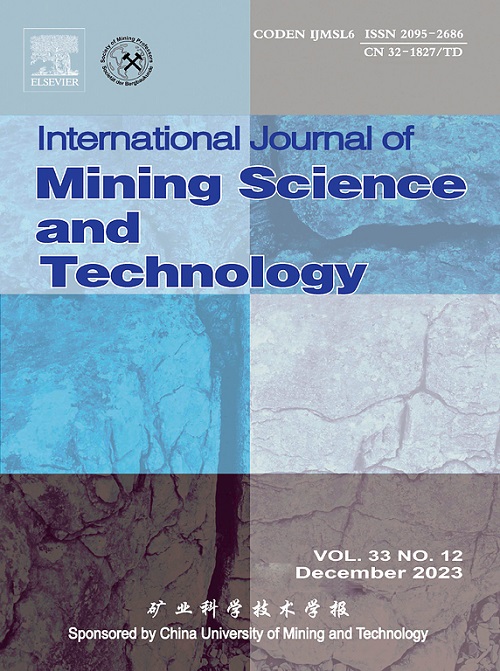Hydraulic fracture propagation in soft coal composite reservoirs: Mechanical responses and energy dissipation mechanisms
IF 11.7
1区 工程技术
Q1 MINING & MINERAL PROCESSING
International Journal of Mining Science and Technology
Pub Date : 2025-04-01
DOI:10.1016/j.ijmst.2025.02.008
引用次数: 0
Abstract
The hydraulic fractures induced in soft coal composite reservoirs have complex extension and energy evolution characteristics. In this study, the mechanism whereby gas outbursts can be eliminated by hydraulic fracturing was revealed. The combined fracturing process of a coal seam and its roof under different in situ stress and fracture spacing conditions was analysed through true triaxial physical tests and numerical simulations. The results showed that the pre-fracturing of the roof had a pressure relief effect on the coal seam, and the secondary pressure relief of the coal seam could be completed at a lower fracture initiation pressure. To ensure the continued presence of the stress shadow effect in actual projects, the fracture spacing should be maintained within the critical range influencing the fracture extension. If the vertical stress is high, a call on increasing the fracture spacing can be taken; otherwise, it must be reduced. In the early phase of fracturing, energy is mostly concentrated at the tip and surface of the fracture; however, the proportion of surface energy for subsequent fracturing is gradually reduced, and the energy is mostly used to open the formation and work on the surrounding matrix. Hydraulic fracturing creates new fractures to interconnect originally heterogeneously distributed gas zones, enabling the entire coal seam to first establish interconnected pressure equilibration, then undergo gradient-controlled depressurization. Hydraulic fracturing can homogenize the stress field and gas pressure field in the original coal seam via communication pressure equalization and reduction decompression, reduce the elastic and extension energies, increase the minimum failure energy required for instability; and realize the elimination of gas outbursts. Our findings provide some theoretical support for the efficient development of coalbed methane and the prevention and control of dynamic gas disasters in coal mines.
软煤复合储层水力裂缝扩展:力学响应与能量耗散机制
软煤复合储层水力裂缝具有复杂的延伸和能量演化特征。研究揭示了水力压裂消除瓦斯突出的机理。通过真三轴物理试验和数值模拟,分析了不同地应力和裂隙间距条件下煤层与顶板的联合压裂过程。结果表明:顶板预裂对煤层具有卸压作用,煤层的二次卸压可以在较低的起裂压力下完成。为保证应力阴影效应在实际工程中持续存在,裂缝间距应保持在影响裂缝延伸的临界范围内。当垂向应力较大时,可提出增大裂缝间距的要求;否则,它必须被简化。在压裂初期,能量主要集中在裂缝尖端和表面;然而,用于后续压裂的表面能所占比例逐渐减少,这些能量主要用于打开地层和作用于周围基质。水力压裂产生新的裂缝,将原本非均质分布的气层相互连接起来,使整个煤层首先建立相互连接的压力平衡,然后进行梯度控制降压。水力压裂通过通压均衡和减减压使原煤层应力场和瓦斯压力场均匀化,降低弹性能和伸展能,增加失稳所需的最小破坏能;并实现消除瓦斯突出。研究结果为煤层气高效开发和煤矿动力瓦斯灾害防治提供了一定的理论支持。
本文章由计算机程序翻译,如有差异,请以英文原文为准。
求助全文
约1分钟内获得全文
求助全文
来源期刊

International Journal of Mining Science and Technology
Earth and Planetary Sciences-Geotechnical Engineering and Engineering Geology
CiteScore
19.10
自引率
11.90%
发文量
2541
审稿时长
44 days
期刊介绍:
The International Journal of Mining Science and Technology, founded in 1990 as the Journal of China University of Mining and Technology, is a monthly English-language journal. It publishes original research papers and high-quality reviews that explore the latest advancements in theories, methodologies, and applications within the realm of mining sciences and technologies. The journal serves as an international exchange forum for readers and authors worldwide involved in mining sciences and technologies. All papers undergo a peer-review process and meticulous editing by specialists and authorities, with the entire submission-to-publication process conducted electronically.
 求助内容:
求助内容: 应助结果提醒方式:
应助结果提醒方式:


